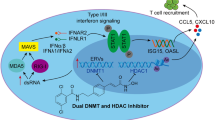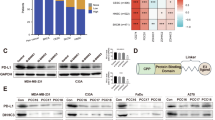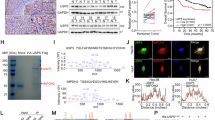Abstract
Tumor cells are characterized by rapid proliferation. In order to provide purines for DNA and RNA synthesis, inosine 5’-monophosphate dehydrogenase (IMPDH), a key enzyme in the de novo guanosine biosynthesis, is highly expressed in tumor cells. In this study we investigated whether IMPDH was involved in cancer immunoregulation. We revealed that the IMPDH inhibitors AVN944, MPA or ribavirin concentration-dependently upregulated PD-L1 expression in non-small cell lung cancer cell line NCI-H292. This effect was reproduced in other non-small cell lung cancer cell lines H460, H1299 and HCC827, colon cancer cell lines HT29, RKO and HCT116, as well as kidney cancer cell line Huh7. In NCI-H292 cells, we clarified that IMPDH inhibitors increased CD274 mRNA levels by enhancing CD274 mRNA stability. IMPDH inhibitors improved the affinity of the ARE-binding protein HuR for CD274 mRNA, thereby stabilizing CD274 mRNA. Guanosine supplementation abolished the IMPDH inhibitor-induced increase in PD-L1 expression. In CT26 and EMT6 tumor models used for ICIs based studies, we showed that despite its immunosuppressive properties, the IMPDH inhibitor mycophenolate mofetil did not reduce the clinical response of checkpoint inhibitors, representing an important clinical observation given that this class of drugs is approved for use in multiple diseases. We conclude that PD-L1 induction contributes to the immunosuppressive effect of IMPDH inhibitors. Furthermore, the IMPDH inhibitor mycophenolate mofetil does not antagonize immune checkpoint blockade.
This is a preview of subscription content, access via your institution
Access options
Subscribe to this journal
Receive 12 print issues and online access
$259.00 per year
only $21.58 per issue
Buy this article
- Purchase on SpringerLink
- Instant access to full article PDF
Prices may be subject to local taxes which are calculated during checkout






Similar content being viewed by others

References
Calise SJ, Abboud G, Kasahara H, Morel L, Chan EKL. Immune response-dependent assembly of IMP dehydrogenase filaments. Front Immunol. 2018;9:2789.
Chen J, Yang S, Li Y, Ziwen X, Zhang P, Song Q, et al. De novo nucleotide biosynthetic pathway and cancer. Genes Dis. 2023;10:2331–8.
Rodriguez-Pascual J, Sha P, Garcia-Garcia E, Rajeshkumar NV, De Vicente E, Quijano Y, et al. A preclinical and clinical study of mycophenolate mofetil in pancreatic cancer. Invest N Drugs. 2013;31:14–9.
He X, Cui J, Ma H, Abuduaini N, Huang Y, Tang L, et al. Berberrubine is a novel and selective IMPDH2 inhibitor that impairs the growth of colorectal cancer. Biochem Pharmacol. 2023;218:115868.
Floryk D, Thompson TC. Antiproliferative effects of AVN944, a novel inosine 5-monophosphate dehydrogenase inhibitor, in prostate cancer cells. Int J Cancer. 2008;123:2294–302.
Hood KA, Zarembski DG. Mycophenolate mofetil: a unique immunosuppressive agent. Am J Health Syst Pharmacol. 1997;54:285–94.
Blaheta RA, Leckel K, Wittig B, Zenker D, Oppermann E, Harder S, et al. Inhibition of endothelial receptor expression and of T-cell ligand activity by mycophenolate mofetil. Transpl Immunol. 1998;6:251–9.
Staatz CE, Tett SE. Pharmacology and toxicology of mycophenolate in organ transplant recipients: an update. Arch Toxicol. 2014;88:1351–89.
Beigel JH, Bao Y, Beeler J, Manosuthi W, Slandzicki A, Dar SM, et al. Oseltamivir, amantadine, and ribavirin combination antiviral therapy versus oseltamivir monotherapy for the treatment of influenza: a multicentre, double-blind, randomised phase 2 trial. Lancet Infect Dis. 2017;17:1255–65.
Pardoll DM. The blockade of immune checkpoints in cancer immunotherapy. Nat Rev Cancer. 2012;12:252–64.
Prestipino A, Zeiser R. Clinical implications of tumor-intrinsic mechanisms regulating PD-L1. Sci Transl Med. 2019;11:eaav4810.
Cha JH, Chan LC, Li CW, Hsu JL, Hung MC. Mechanisms controlling PD-L1 expression in cancer. Mol Cell. 2019;76:359–70.
Huang F, Huffman KE, Wang Z, Wang X, Li K, Cai F, et al. Guanosine triphosphate links MYC-dependent metabolic and ribosome programs in small-cell lung cancer. J Clin Invest. 2021;131:e139929.
Chen B, Hu J, Hu X, Chen H, Bao R, Zhou Y, et al. DENR controls JAK2 translation to induce PD-L1 expression for tumor immune evasion. Nat Commun. 2022;13:2059.
Fan Z, Wu C, Chen M, Jiang Y, Wu Y, Mao R, et al. The generation of PD-L1 and PD-L2 in cancer cells: from nuclear chromatin reorganization to extracellular presentation. Acta Pharm Sin B. 2022;12:1041–53.
Schoenberg DR, Maquat LE. Regulation of cytoplasmic mRNA decay. Nat Rev Genet. 2012;13:246–59.
Vlasova-St Louis I, Bohjanen PR. Post-transcriptional regulation of cytokine and growth factor signaling in cancer. Cytokine Growth Factor Rev. 2017;33:83–93.
Yang K, Zhou J, Chen Y, Chen Y, Chen L, Zhang P, et al. Angiotensin II contributes to intratumoral immunosuppressionvia induction of PD-L1 expression in non-small cell lung carcinoma. Int Immunopharmacol. 2020;84:106507.
Zhang W, Pan X, Xu Y, Guo H, Zheng M, Chen X, et al. Mevalonate improves anti-PD-1/PD-L1 efficacy by stabilizing CD274 mRNA. Acta Pharm Sin B. 2023;13:2585–600.
Coelho MA, de Carne Trecesson S, Rana S, Zecchin D, Moore C, Molina-Arcas M, et al. Oncogenic RAS signaling promotes tumor immunoresistance by stabilizing PD-L1 mRNA. Immunity. 2017;47:1083–99. e6
Zhang J, Bu X, Wang H, Zhu Y, Geng Y, Nihira NT, et al. Cyclin D-CDK4 kinase destabilizes PD-L1 via cullin 3-SPOP to control cancer immune surveillance. Nature. 2018;553:91–5.
Armstrong VW, Tenderich G, Shipkova M, Parsa A, Koerfer R, Schroder H, et al. Pharmacokinetics and bioavailability of mycophenolic acid after intravenous administration and oral administration of mycophenolate mofetil to heart transplant recipients. Ther Drug Monit. 2005;27:315–21.
Xu H, Ma H, Zha L, Li Q, Yang G, Pan H, et al. IMPDH2 promotes cell proliferation and epithelial-mesenchymal transition of non-small cell lung cancer by activating the Wnt/beta-catenin signaling pathway. Oncol Lett. 2020;20:219.
Sagiv-Barfi I, Kohrt HE, Czerwinski DK, Ng PP, Chang BY, Levy R. Therapeutic antitumor immunity by checkpoint blockade is enhanced by ibrutinib, an inhibitor of both BTK and ITK. Proc Natl Acad Sci USA. 2015;112:E966–72.
Idos GE, Kwok J, Bonthala N, Kysh L, Gruber SB, Qu C. The prognostic implications of tumor infiltrating lymphocytes in colorectal cancer: a systematic review and meta-analysis. Sci Rep. 2020;10:3360.
Youn JC, Stehlik J, Wilk AR, Cherikh W, Kim IC, Park GH, et al. Temporal trends of de novo malignancy development after heart transplantation. J Am Coll Cardiol. 2018;71:40–9.
Zeier M, Hartschuh W, Wiesel M, Lehnert T, Ritz E. Malignancy after renal transplantation. Am J Kidney Dis. 2002;39:E5.
Al-Adra D, Al-Qaoud T, Fowler K, Wong G. De novo malignancies after kidney transplantation. Clin J Am Soc Nephrol. 2022;17:434–43.
Marcen R. Immunosuppressive drugs in kidney transplantation: impact on patient survival, and incidence of cardiovascular disease, malignancy and infection. Drugs. 2009;69:2227–43.
Lin JY, Wang J, Mishra K, Osmani S, Rumsey K, Singh PP, et al. Non-melanoma skin cancer in solid organ transplant recipients with skin of color. J Am Acad Dermatol. 2024;90:159–60.
Buell JF, Gross TG, Woodle ES. Malignancy after transplantation. Transplantation. 2005;80:S254–64.
Dierickx D, Habermann TM. Post-transplantation lymphoproliferative disorders in adults. N Engl J Med. 2018;378:549–62.
Briggs JD. Causes of death after renal transplantation. Nephrol Dial Transpl. 2001;16:1545–9.
Vegso G, Toth M, Hidvegi M, Toronyi E, Langer RM, Dinya E, et al. Malignancies after renal transplantation during 33 years at a single center. Pathol Oncol Res. 2007;13:63–9.
Robert C. A decade of immune-checkpoint inhibitors in cancer therapy. Nat Commun. 2020;11:3801.
Mullen NJ, Singh PK. Nucleotide metabolism: a pan-cancer metabolic dependency. Nat Rev Cancer. 2023;23:275–94.
Kofuji S, Hirayama A, Eberhardt AO, Kawaguchi R, Sugiura Y, Sampetrean O, et al. IMP dehydrogenase-2 drives aberrant nucleolar activity and promotes tumorigenesis in glioblastoma. Nat Cell Biol. 2019;21:1003–14.
Naffouje R, Grover P, Yu H, Sendilnathan A, Wolfe K, Majd N, et al. Anti-tumor potential of IMP dehydrogenase inhibitors: a century-long story. Cancers. 2019;11:1346.
Wawrzyniak JA, Bianchi-Smiraglia A, Bshara W, Mannava S, Ackroyd J, Bagati A, et al. A purine nucleotide biosynthesis enzyme guanosine monophosphate reductase is a suppressor of melanoma invasion. Cell Rep. 2013;5:493–507.
Shireman JM, Atashi F, Lee G, Ali ES, Saathoff MR, Park CH, et al. De novo purine biosynthesis is a major driver of chemoresistance in glioblastoma. Brain. 2021;144:1230–46.
Keshet R, Lee JS, Adler L, Iraqi M, Ariav Y, Lim LQJ, et al. Targeting purine synthesis in ASS1-expressing tumors enhances the response to immune checkpoint inhibitors. Nat Cancer. 2020;1:894–908.
Acknowledgements
This work was supported by the National Natural Science Foundation of China (No. 82330114 to QJH, and No. 82273949 to LD).
Author information
Authors and Affiliations
Contributions
MMZ contributed to the design, performed experiments and wrote the manuscript; JYL, HJG, JZ, LSW, KFJ, HHW and QJH contributed to the acquisition of the work, performed the statistical analysis and revised the article; LD and BY contributed to the conception of the work and provided project supervision.
Corresponding authors
Ethics declarations
Competing interests
The authors declare no competing interests.
Supplementary information
Rights and permissions
Springer Nature or its licensor (e.g. a society or other partner) holds exclusive rights to this article under a publishing agreement with the author(s) or other rightsholder(s); author self-archiving of the accepted manuscript version of this article is solely governed by the terms of such publishing agreement and applicable law.
About this article
Cite this article
Zheng, Mm., Li, Jy., Guo, Hj. et al. IMPDH inhibitors upregulate PD-L1 in cancer cells without impairing immune checkpoint inhibitor efficacy. Acta Pharmacol Sin 46, 1058–1067 (2025). https://doi.org/10.1038/s41401-024-01411-8
Received:
Accepted:
Published:
Issue date:
DOI: https://doi.org/10.1038/s41401-024-01411-8


